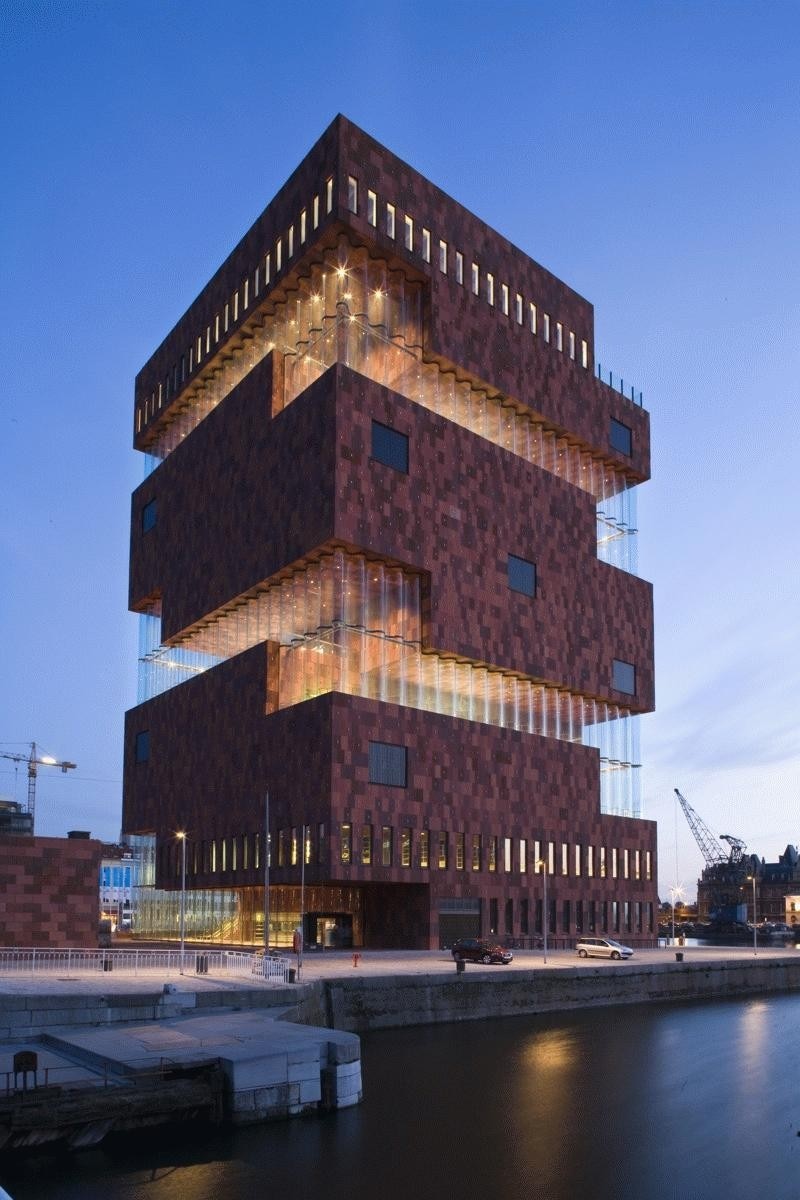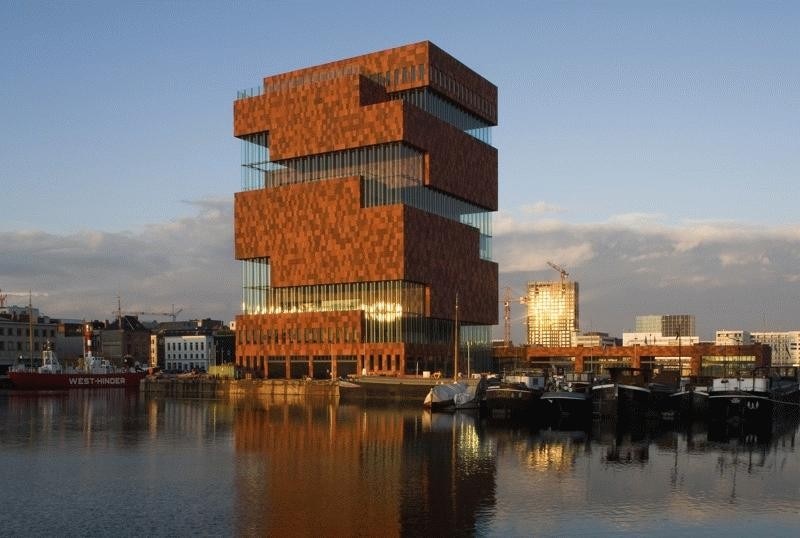The location
The MAS | Museum aan de Stroom stands between the old docks in the centre of the Eilandje. This old harbour area is the most important city renovation project in the centre of Antwerp and is in full development as a new dazzling city district.
The building
The MAS was designed as a sixty-metre high tower. Ten gigantic natural stone trunks are piled up as a physical demonstration of the heaviness of history, full of historical objects that are the legacy of our ancestors. It is a storehouse of stacked history in the middle of the old harbour docks. Every storey of the tower has been rotated a quarter turn, creating a gigantic spiral staircase. This spiral space, in which a facade of corrugated glass is inserted, forms a public city gallery.
The spiral route
A route of escalators leads the visitors up from the square up to the top of the tower. The story of the city, its harbour and inhabitants is told in the spiral tower. Visitors can enter a museum hall on every level and reflect on the history of the dead city, while on the way up breath-taking panoramas unfold above the living city. The top of the tower accommodates a restaurant, a party room and a panoramic terrace, where the present is celebrated and the future is planned.
The facades
Facades, floors, walls and ceilings of the tower are entirely covered with large panels of hand-cut red Indian sandstone, evoking the image of a monumental stone sculpture. The four-colour variation of the natural stone panels has been distributed over the facade on the basis of a computer-generated pattern. The spiral gallery is finished with a gigantic curtain of corrugated glass. Its play of light and shadow, of transparency and translucence turns this corrugated glass facade into a light counterweight to the heavy stone sculpture.
The ornaments
In order to soften the monumental tower volume, a pattern of metal ornaments has been attached to the facade as a veil. The ornaments have the shape of hands, the symbol of the City of Antwerp. This pattern is continued inside the building by means of metal medallions, cast according to a design by Tom Hautekiet with a text by Tom Lanoye.
The museum square
The museum square at the base of the tower is an integral part of the design. The square has been designed in the same red natural stone as the tower and is surrounded by pavilions and terraces as an urban area for events and open-air exhibits. The central part of the plaza is sunken and forms a framework for the large mosaic by Luc Tuymans.
The building is set up as a flexible museum machine which can be used and arranged in all sorts of ways on the basis of the changing visions of curators, scenographers and concession holders. Neutelings Riedijk Architects has no further involvement in the elaboration of the interior or the scenography. The scenography of the first exhibits is to be set-up by B-Architecten; the cafeteria, party hall and the restaurant by the decorators of the concession holders, and the pavilions by the Founders interior decorators. The 62-metre high MAS tower is supported by a 12x12 metre central core of concrete poured on site. Steel frames are suspended from this core, extending 12 metres. The frames form a balance structure on either side of the core in accordance with the milk maid principle. The frames are still partially visible in the exhibition halls as large V components that divide the areas of the halls. The outer walls are suspended from the outer ends of the frames, which in turn support the floor components. The floor components consist of 12-metre long prefabricated concrete TT girders. The typical main sculptural form of the building is created in this way without a single column, as a stack of cantilevered halls. The monolithic nature of the building is softened by the corrugated glass curtain that enfolds the gallery. This transparent facade is made up of large glass sheets, 5.5 metres high and 1.80 metres wide. The sheets are curved into an S wave with a depth of 60 cm, which stabilises every glass sheet and makes it self-supporting, so the sheets can stand free on the floor without any window profiles. In this way, maximum transparency is accomplished without interrupting components. In the corners two glass panes support one another up to a height of 11 metres. A steel tube suspended from a heavy chain ensures horizontal transfer of the wind loads. The basic assumption of the MAS design was to achieve a low-energy and sustainable concept within the strict international standards imposed on the indoor climate of a museum. In order to prevent this strict climate requirement from applying to the entire building, the option was selected to establish different climate zones in the building: the museum halls on the one hand, and the gallery on the other.



